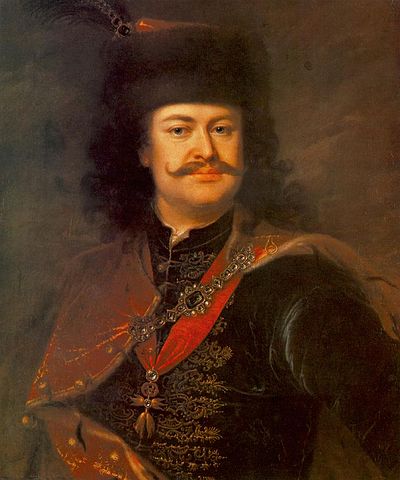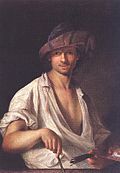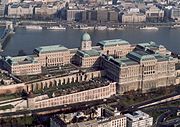
File:II. Rákóczi Ferenc Mányoki.jpg

| |
This is a file from the Wikimedia Commons. Information from its description page there is shown below.
Commons is a freely licensed media file repository. You can help. |
Summary
| Artist |
|
||||||||||||||||||||
| Title | Portrait of Prince Ferenc Rákóczi II | ||||||||||||||||||||
| Date | 1724 | ||||||||||||||||||||
| Medium | oil on canvas | ||||||||||||||||||||
| Dimensions | Height: 77.5 cm (30.5 in). Width: 62.5 cm (24.6 in). | ||||||||||||||||||||
| Current location |
|
||||||||||||||||||||
| Source/Photographer | Fine Arts in Hungary: |
||||||||||||||||||||
Licensing
| Public domainPublic domainfalsefalse |
 |
This image (or other media file) is in the public domain because its copyright has expired. This applies to Australia, the European Union and those countries with a copyright term of life of the author plus 70 years.
|
|
|
|
File usage
Metadata
| JPEG file comment | MÁNYOKI Ádám (1673, Szokolya - 1757, Drezda) II. Rákóczi Ferenc képmása 1724 Olaj, vászon, 77,5 x 62,5 cm Magyar Nemzeti Galéria, Budapest Mányoki Ádámnak II. Rákóczi Ferencrõl készült képmása nemcsak a magyar barokk portréfestészet legszebb alkotása, de a festõ oeuvre-jének is kiemelkedõ darabja. Mányokinak e mûve a fejedelem büszke egyéniségének, elõkelõ megjelenésének és nemes méltóságának legjobb megörökítõje. Az erdélyi fejedelmi családból származó Rákóczi a bécsi udvar körültekintõ felügyelete alatt korszerû jezsuita nevelésben részesült. Neuhaus és Prága jezsuita iskoláiban megalapozott mûveltségét fõként ízlésének finomítása és mûvészi igényessége szempontjából itáliai útja tette teljessé, amelynek során hosszan idõzött több jelentõs városban. A szolgálatba állott Mányoki Ádám tevékenységétõl nemcsak az európai fejedelemi udvarok mûvészi színvonalát elérõ saját udvari mûvészetet, de politikai törekvéseinek képzõmûvészeti propagálását is remélte. E meggondolások vezették, amikor udvari festõjét 1709-ben hollandiai tanulmányútra küldte. Mányokinak Rákócziról készült képmása e holland tanulmányút tapasztalatainak összegzése. A kép a függetlenségi harc elbukása miatt emigrációba kényszerült fejedelem lengyelországi tartózkodása idején, 1712-ben Gdanskban készült. Mányoki a fejedelmet elöl hímzett díszes magyar öltözékben állítja elénk. Hajának, prémes kucsmájának sötétjébõl övezett arcára erõs fénysugár vetül, amely nemcsak vonásainak érzékeny megörökítését segíti, de Mányoki jellemábrázoló erejének legjavát is feltárja. Jól megfigyelhetõ, hogy a holland portréfestészet tanulmányozása hozzásegítette a festõt az egységes fény- és tónushatás érvényesítéséhez, lélekrajz és annak festõi megoldását támogató mérsékelt ünnepélyesség képi egyensúlyához. Az uralkodói reprezentáció a bujdosó fejedelem arcképében csak rejtve, finom utalásokkal érvényesül. Palást módjára hátára vetett, elöl magyar ötvösmûvû mentekötõ lánccal összekapcsolt bíborszínû dolmányát uralkodói hermelin béleli. Nyakában az aranygyapjas rendet viseli, amelyet 1709-ben kapott meg. MÁNYOKI, Ádám (1673, Szokolya - 1757, Dresden) Portrait of Prince Ferenc Rákóczi II 1724 Oil on canvas, 77,5 x 62,5 cm Hungarian National Gallery, Budapest This portrait of Ferenc Rákóczi II is not only the most beautiful example of Hungarian baroque portrait-painting but also one of Mányoki's most outstanding works. It is our finest memento of the Prince, splendidly conveying his distinction of mind and body, his pride, his dignity, his nobility. Born into the Transylvanian nobility, Rákóczi received a modern education from the Jesuits under the watchful supervision of the Court in Vienna. His studies at the Jesuit schools in Neuhaus and Prague were complemented by travel in Italy where he spent lengthy periods in several large cities and developed a knowledge and appreciation of art. By employing the services of Ádám Mányoki, he hoped to establish a court art of his own, equal to that of other European courts, and to propagate at the same time his political endeavours through art. These considerations prompted him in 1709 to send his court painter to the Netherlands to study Dutch painting. In his portrait of Rákóczi Mányoki made use of all that he had learned in the Netherlands. The picture dates from 1712 and was painted in Gdañsk, Poland, to which country the Prince had emigrated after the defeat of the War of Independence led by him. He is depicted in Hungarian costume adorned with embroidery on the front. The strong light on his face and the contrasting dark hair and fur-cap serve to emphasize the features, thus revealing the artist's sensitive understanding of the Prince's character. It is evident that Mányoki's study of Dutch portrait-painting had taught him how to produce consistent effect of light and tone and to create a pictorial balance whilst at the same time achieving a subtle degree of characterization in his portraits. In this painting of the exiled Prince the artist has merely hinted at the symbols of royalty. The scarlet dolman worn like a cloak and fastened at the front with a chain of Hungarian goldsmith's work, is lined with ermine, as befitted a royal personage. Round his neck the Prince is wearing the Order of the Golden Fleece, awarded in 1709. Type: portrait Time-line: 1701-1750 Form: painting |
|---|
Learn more about Schools Wikipedia
Schools Wikipedia has made the best of Wikipedia available to students. By supporting vulnerable children right through to adulthood, SOS Childrens Villages makes a lasting difference to the lives of thousands of people. Education is a key part of our work, and our schools provide high-quality teaching to the children in our care. There are many ways to help with SOS Children.


